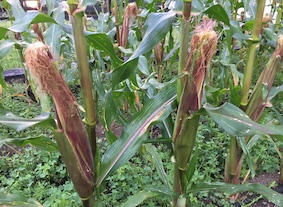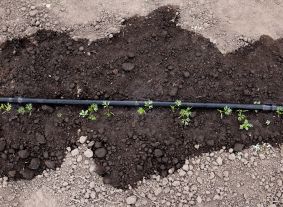Why Corn Leaves Turn Red
Views: 9585

Why do corn leaves turn red? That was my sister’s text to me last week. Actually, she sent me a photo of her Northern Virginia garden, focused in on her corn crop, and asked, “What is going on with our corn?” The corn crop wasn’t robust, with corn height varying and that strange reddish tint on many of the skinny stalks. The corn tassels were also still blonde or strawberry blonde. They should be a rust or dark coffee color they should be in mid-September. She opened an ear or two and saw undeveloped kernels along the cob.
What indeed was going on? My sister being my sister, she set straight to work figuring out the problem while I was still drinking my morning coffee. Stress and too much sugar being produced, she wrote. But why? What stress causes too much sugar production?
Excess Heat, Excess Sugars
I did a little Googling myself to find out what stressors could produce too much sugar and also impact pollination. The websites I found with the information are from the university agricultural extension departments of major corn-producing states (Nebraska and Kentucky). If anyone should know what’s going on with a corn crop, it’s them.
In a nutshell, corn leaves and stalks become red as a result of prolonged periods of high temperatures during the period of pollination. In a specific 2012 case that University of Kentucky used as an example, temperatures exceeded 100F for seven consecutive days. The high temperatures lead to low pollination, which leads to low kernel development. When corn kernels production on plant is low, the plant can’t use all the sugar it has produced by photosynthesis. And when there is too much sugar in the plant, the sugar turns the plant red to purplish-red.
Heat Impacts Corn Pollination
But why does heat impact pollination in the first place? Isn’t corn a tropical grass and shouldn’t it be accustomed to the heat? According to a University of Nebraska publication, corn maximizes its production at 86F. Silk development (where the stigma/style/ovaries reside) slows down with extended high temperatures , and that can lead it to lagging behind the timing when corn pollen releases into the air. Even if the silk timing is spot on, high temperatures can dry out the silk, making pollination difficult to impossible. The article also points out that high temperatures can reduce the amount of pollen that is shed and impact the viability of what’s produced.
My sister is still waiting for the corn to get as big it as can and harvesting what corn she can. That is, if the raccoons don’t get to it first.
Meet Ellen Wells
When you’re raised on a farm, you can’t help but know a thing or two about gardening. Ellen Wells is our expert on edible gardening.…
Ellen's Recent Posts

Asparagus






